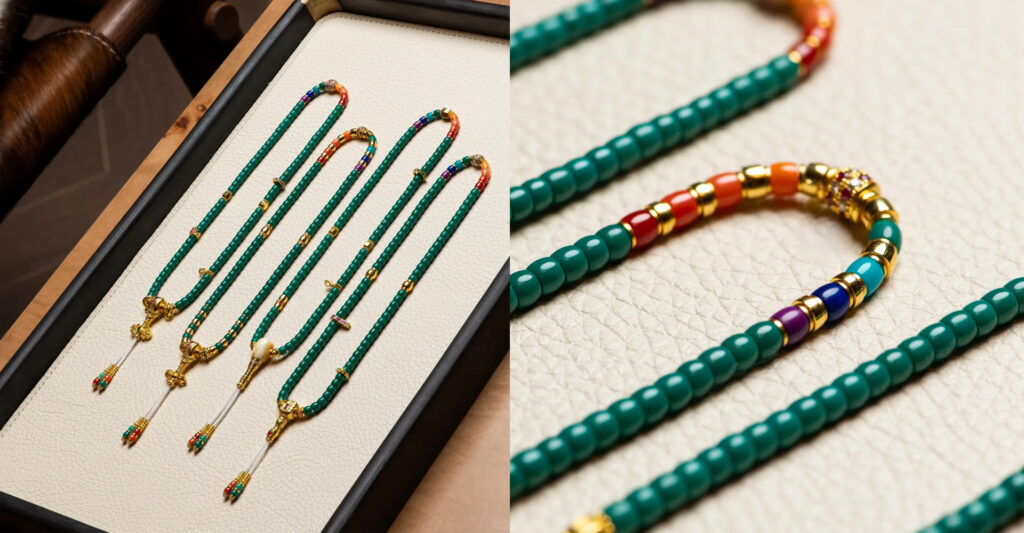Cultured bead bracelets, as the name suggests, are bracelets or Buddhist prayer beads, originally called rosaries. They refer to portable religious implements strung together with thread, consisting of a specific number of beads, used for counting during Buddhist chanting or mantra recitation. The specific significance of the number of beads may vary depending on culture, tradition, and personal interpretation.

1 bead: Symbolizes a fortune-changing bead, signifying lifelong good fortune;
3 beads: Symbolize the “Buddha, Dharma, Sangha” and “body, speech, mind,” signifying the fulfillment and smooth progress of all endeavors;
4 beads: Symbolize the Four Conditions—conditioned cause, non-interrupted condition, object of cognition, and enhancing condition;
5 beads: Symbolize the Five Vehicles—Human Vehicle, Heavenly Vehicle, Shravaka Vehicle, Pratyeka Buddha Vehicle, Bodhisattva Vehicle;
6 beads: Symbolize the “Six Roots and Six Senses”—ear, nose, tongue, eye, body, and mind—representing the six senses and perceptions, signifying healthy growth, suitable for children;
7 beads: Symbolize the Seven Excellent Dharmas, also known as the Seven Knowledges, Seven Virtues, or Seven Good Dharmas: Knowing the Dharma, Knowing the Meaning, Knowing the Time, Knowing Contentment, Knowing Oneself, Knowing the Assembly, Knowing Hierarchy;
8 beads: Symbolize the Eightfold Path, representing the eight methods and approaches to attain the Buddhist ideal.
9 beads: Symbolize the nine realms—past, present, and future, each comprising three realms, totaling nine;
10 beads: Symbolize the ten benefits, referring to the various tenfold advantages scattered throughout the sutras;
11 beads: Symbolize the eleven powers of Amitabha Buddha bestowed upon practitioners of Buddha-recitation, signifying the complete elimination of all demonic disturbances;
12 beads: Symbolize the Twelve Links of Dependent Origination, signifying that virtuous causes yield virtuous results and lead to triumphant beginnings;
13 beads: Symbolize the Thirteen Powers possessed by Bodhisattvas in the Western Pure Land; 16 beads: Symbolize the Sixteen Guardian Deities, referring to the sixteen benevolent deities who protect the Prajnaparamita Sutra and its reciters; 18 beads: Symbolize the eighteen Arhats, eighteen kinds of wisdom, or the “eighteen sons.” Here, ‘eighteen’ refers to the “eighteen realms”—the six sense organs, six sense objects, and six consciousnesses;
21 beads: Symbolize the “twenty-one stages of Buddhahood,” representing the ten grounds, ten paramitas, and the twenty-one levels of Buddhahood, signifying step-by-step advancement; Symbolizing the 27 Buddhist sages (the twenty-seven stages of learning in the Hinayana path: the eighteen “learned ones” achieving the first three fruits, and the nine “non-learned ones” attaining the fourth Arhat fruit), signifying profound erudition and mastery in all fields;
36 beads: Symbolize the 108-bead portable version, where one-third of 108 beads equals 36. Representing 36 benevolent deities, signifying good fortune and happiness. 42 beads: Represent the forty-two stages of a Bodhisattva’s cultivation: the Ten Stages of Dwelling, Ten Stages of Practice, Ten Stages of Dedication, Ten Grounds, Equal Enlightenment, and Supreme Enlightenment. 54 beads: Symbolize the 54 stages of spiritual realization, signifying perfect wisdom. This includes the fifty stages of “Ten Faiths, Ten Abodes, Ten Practices, Ten Dedications, Ten Grounds,” plus the “Four Good Roots” stage;
108 beads: Represent the elimination of 108 afflictions, praying for liberation from suffering, attainment of joy, and peace, thereby achieving a state of tranquil mind and body. The 108 afflictions are described in various ways. Generally, each of the six sense organs experiences three sensations—pleasure, pain, and neutrality—totaling eighteen. Additionally, each sense organ perceives three qualities—good, bad, and neutral—also totaling eighteen. These thirty-six aspects are then combined with the three realms of past, present, and future, resulting in the 108 afflictions.
1080: Represents the ten realms each containing one hundred and eight afflictions, totaling one thousand and eighty afflictions. The “ten realms” signify the entire world of delusion and enlightenment, divided into ten categories: the hell realm, the hungry ghost realm, the animal realm, the asura realm, the human realm, the heavenly realm, the shravaka realm, the pratyekabuddha realm, the bodhisattva realm, and the Buddha realm.
Four Good Roots: Warmth Stage, Summit Stage, Endurance Stage, World’s Supreme Stage;
Six Sense Organs: Eye Realm, Ear Realm, Nose Realm, Tongue Realm, Body Realm, Mind Realm;
Six Dusts: Form Dust, Sound Dust, Scent Dust, Taste Dust, Touch Dust, Mental Dust;
Six Consciousnesses: Eye consciousness, ear consciousness, nose consciousness, tongue consciousness, body consciousness, mind consciousness;
Nine Unlearned Dharmas: The Dharma of Retreat, the Dharma of Reflection, the Dharma of Protection, the Dharma of Abiding, the Dharma of Attainment, the Dharma of Immovability, the Dharma of Non-Retreat, Wisdom Liberation, and Complete Liberation; Ten Faiths: Faith Mind, Mindfulness Mind, Diligence Mind, Wisdom Mind, Concentration Mind, Non-Retreat Mind, Dharma-Protection Mind, Dedication Mind, Precepts Mind, Aspiration Mind; Ten Abodes: Initial Aspiration Abode, Ground-Cultivation Abode, Practice Abode, Noble Birth Abode, Complete Expedient Means Abode, Right Mind Abode, Non-Retrogression Abode, Youthful Purity Abode, Prince Abode, Crown-Conferral Abode;
Ten Practices: Joyful Practice, Beneficial Practice, Practice Without Resentment, Boundless Practice, Practice Free from Delusion and Disturbance, Skillful Manifestation Practice, Non-Attachment Practice, Respectful Practice, Practice of True Dharma;
Ten Dedications: Dedication to Delivering All Beings from the Mark of Sentient Beings, Indestructible Dedication, Dedication to Equalizing with All Buddhas, Dedication to Reaching Everywhere, Dedication to the Treasury of Infinite Merit, Dedication to Following Equal Meritorious Roots, Dedication to Equally Contemplating All Beings, Dedication to Identical Form, Dedication to Unfettered and Unattached Liberation, Dedication to the Boundless Dharma Realm;
Ten Grounds: Joyful Ground, Purity Ground, Radiance Ground, Flame Wisdom Ground, Difficult-to-Conquer Ground, Manifestation Ground, Far-Reaching Ground, Unshakable Ground, Good Wisdom Ground, Dharma Cloud Ground;
Eighteen Stages of the Learner: The Follower of Faith, The Follower of the Dharma, The Believer with Understanding, The Attainer of Insight, The Body-Realizer, The Dweller in One Home, The Dweller in One Room, The Aspirant to Stream-entry, The Attainer of Stream-entry, The Aspirant to Once-returning, The Attainer of Once-returning, The Aspirant to Non-returning, The Attainer of Non-returning, The Dweller in the Middle Path, The Dweller in Birth, The Dweller with Practice, The Dweller without Practice, The Dweller in the Upper Stream.